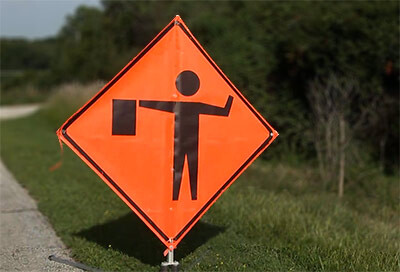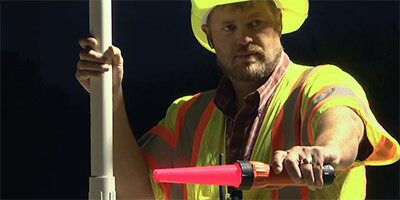List items for Flagging in Different Situations

In emergencies, the following equipment and procedures may be used on a short-term temporary basis. However, provide standard traffic control as soon as possible.
If the STOP/SLOW paddle is not available, use a good-quality red flag to regulate traffic in emergency situations.
The flag shall have the minimum:
- dimensions of 24 inches by 24 inches (600 mm by 600 mm),
- minimum 3-foot (0.9 m) handle,
- free edge of the flag should be weighted so the flag will hang vertically even in windy conditions.
Nighttime Emergency Situations

A flashlight with a red glow cone may be used in addition to the red flag. Retroreflectorized clothing shall be worn.
Follow the procedures for stopping and releasing traffic under Two-Flagger Operations.
When flagging near railroad crossings, be sure your flagging station is not located where traffic may be backed up over the crossing. If the flagger position cannot be moved, an additional flagger will be needed to keep the crossing clear of stopped traffic.
- Work in the vicinity of a grade crossing. See Railroad Crossing illustration.
Generally, traffic control procedures are the same for haul road intersections as for other work areas. Follow the procedures for stopping and releasing traffic under Two-Flagger Operations.
- When trucks are making a right turn onto the highway, only one flagger may be required.
- When trucks are crossing the highway or making a left turn, two flaggers may be required, one for each direction.
When work activities occur in an intersection, additional flaggers may be needed.
Communication among flaggers is essential. Do not direct drivers through red lights at intersections with traffic signals. Signals should be deactivated to avoid confusion.
Mobile work zones present particular challenges for flaggers. Because you may be moving down the road with the other workers, your visibility and conflicts from intersecting roads and driveways are continually changing.